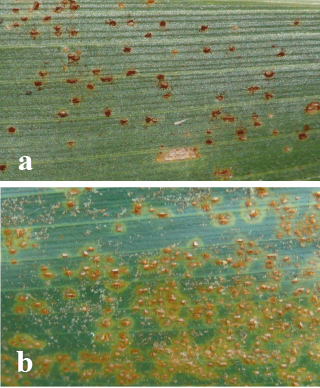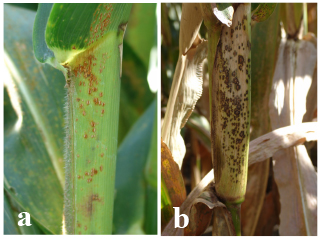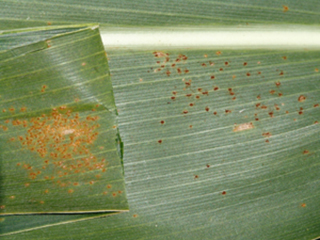G1680
Rust Diseases of Corn in Nebraska
Identification and management of rust diseases of corn are discussed in this NebGuide.
Tamra A. Jackson-Ziems, Extension Plant Pathologist
Introduction
Two rust diseases of corn occur in Nebraska and in other temperate areas. Common rust of corn occurs every year to some extent, and is caused by the fungus Puccinia sorghi. The other rust disease, southern rust, is caused by Puccinia polysora and occurs less frequently in Nebraska. Both diseases can increase in severity rapidly, particularly if infection occurs early in the growing season and favorable environmental conditions persist for extended periods of time. Southern rust poses a much greater threat than common rust to field dent corn production because it is a more aggressive pathogen and most corn hybrids lack resistance.
Timing of disease development and its severity determine the extent of yield loss. Yield loss estimates of up to 45 percent have been reported in Florida, due to severe southern rust. For each 10 percent leaf area infected by common rust, approximately 6 percent of yield loss was reported in Illinois sweet corn.
|
|
Symptoms and Identification
Common Rust
The most useful visual characteristic differentiating common and southern rust is the location of sporulating pustules (pustules where spores are produced). Common rust pustules frequently occur on both the upper and lower leaf surfaces. Pustules of the common rust fungus tend to be circular to elongate, darker in color (Figure 1a), less densely scattered, and slightly larger than those of southern rust that appear on the upper leaf surface. Pustules darken in color later in the season as the fungus produces teliospores instead of red urediniospores.
Southern Rust
In contrast to the pustules of common rust, those of southern rust are circular to oval, light cinnamon-brown to orange in color and predominantly on the upper-leaf surface (Figure 1b). Pustules tend to occur only sparsely on the leaf underside, but may occur abundantly on the leaf sheath (Figure 2a). Haloes can be observed in some hybrids around pustules when leaves are backlit (Figure 3). The pustules are usually more densely clustered than those of common rust. And, like common rust, the pustules can darken in color later in the season as the spore type changes (Figure 2b).
Diagnosis
Symptoms of common and southern rust may appear similar to each other and sometimes differ from those shown in photos due to environmental conditions, hybrid genetics, and other factors. As a result, differentiating between these diseases may be difficult. If you need assistance identifying these or other diseases, collect and submit a fresh sample to the UNL Plant and Pest Diagnostic Clinic or comparable diagnostic laboratory in your area. In the laboratory, specialists use microscopes (and sometimes other tools and tests) to examine pathogen(s) and their specific characteristics.
Diagnosticians use the shapes of rust urediniospores, which differ by species, to identify which rust disease(s) are present on samples. In particular, the predominant shape of spores differs between the pathogens causing common rust and southern rust. The common rust pathogen spores are usually round, while those of the southern rust fungus are usually more oblong or ellipsoid (Figure 4). However, caution must be taken when evaluating spore shapes, as shapes can vary significantly. The shape of many spores (at least 100) must be observed and compared before determining a final diagnosis. Immature spores produced by the southern rust fungus might be more round than oval in shape and may be misdiagnosed as common rust spores during the early stages of infection. In addition, it is possible to have co-infections or contamination where both pathogens’ spores are present.
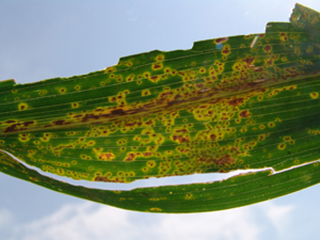 |
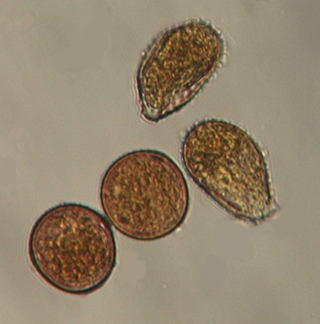 |
|
Figure 3. Haloes surrounding southern rust pustules can be observed in some hybrids. |
Figure 4. Urediniospores (magnified 400X) of P. sorghi (common rust, lower left) and P. polysora (southern rust, upper right). (Photo courtesy of Amy Timmerman, UNL Extension). |
The major characteristics of the two rust diseases are summarized in Table I.
Table I. A comparison of corn rust characteristics (Figure 5). |
||
| Characteristic | Common Rust | Southern Rust |
| Causal agent | Puccinia sorghi | Puccinia polysora |
| Pustule location | Both leaf surfaces | Mainly upper leaf surface |
| Pustule color | Brick red, golden brown to cinnamon brown | Light cinnamon-brown to orange |
| Pustule distribution | Sparsely scattered | Dense clusters |
| Predominant urediniospore shape | Round | Oblong to elllipsoid |
| Optimal temperatures | 61-77°F | 77-82°F |
| Management | Resistance, fungicide application, and planting early | |
|
Disease Development
Most rust diseases, including common and southern on corn, are caused by obligate parasites that require living plant tissue in order to survive. Thus, these pathogens cannot survive the winters in Nebraska.
Viable urediniospores must travel north into Nebraska every year from warmer southern climates where these fungi overwinter. The incidence and severity of disease development depends largely on weather conditions and the reactions of corn hybrids.
Rust fungi only require six hours or more of either relative humidity ≥95 percent or leaf wetness for spore germination and infection, but differ in their optimal temperature range.
Urediniospores, formed in the pustules, cause repeated secondary infections and may be produced abundantly. In fact, up to 5,000 spores have been reportedly produced per common rust pustule, indicating the tremendous reproductive capacity of rust fungi.
Southern rust tends to cause greater yield loss than common rust, reportedly up to 45 percent. Severe epidemics of southern rust have been rare in Nebraska. The epidemic of 2006 can be blamed on the simultaneous development of above-normal night temperatures and excessive rainfall in August. Severe infections (Figure 6) can impact yield by causing leaf damage leading to defoliation and premature senescence, but the disease often develops late in the season, which minimizes its impact on yield. Corn planted later than normal has younger leaf tissue later during the season. Young leaf tissue is more susceptible to infection and plants have a longer time remaining for grain-fill, making them more vulnerable to damage. Thus, corn fields that are planted later are more prone to yield loss due to rusts, particularly southern rust.
There are five spore stages in the disease cycle of the common rust fungus. In North America, initial and repeated infection is by urediniospores that are blown into the area annually on wind currents. Urediniospores produced on corn serve as secondary inoculum locally and are spread great distances to corn in temperate regions, such as the U.S. Corn Belt, where they serve as primary inoculum for disease development. The fungus only overwinters in tropical and subtropical areas, so there is no accumulation of fungal inoculum in Nebraska fields or debris that will infect during subsequent growing seasons.
Urediniospores serve as both primary and secondary inoculum for initial and repeated infections, respectively, for the southern rust fungus. Although, in Nebraska, the fungus produces dark teliospores later in the season (Figure 2), they do not germinate and are considered unimportant in the disease cycle. No alternate hosts have been identified for this fungus and urediniospores and teliospores are the only known spore stages. Similar to the common rust fungus, the southern rust fungus overwinters in tropical and subtropical areas, so disease and inoculum from the previous year do not contribute to future disease severity.
Potential exists for some important secondary effects of rusts. Severe rust can cause premature defoliation of plants. The plant’s priority is to fill grain with the resources provided by the leaves. When the leaves can no longer act as the source for these nutrients, the plant cannibalizes the stalk to obtain them. Removing resources from the stalk weakens it, predisposing it to stalk rot diseases and lodging, both of which can adversely affect yield.
Management
Some years, rusts can be severe in Nebraska. This situation requires applying management strategies to reduce the negative impact of the disease(s) on yield. A number of management options are available to treat for rust diseases of corn, ranging from the use of resistant hybrids to fungicides and cultural practices.
Plant Resistance
Deployment of resistance is a management strategy used in the southeastern United States, but is not a primary focus of breeding efforts in much of the Midwest because rust diseases are not a persistent and significant annual threat to corn production here. Consequently, only about 40 percent of seed companies represented in Nebraska evaluate their hybrids’ reactions to common rust and only 10 percent provide hybrid ratings for reactions to southern rust.
Fungicides
There are numerous fungicides labeled for use on corn that can effectively control rust diseases with timely application. Refer to the most recent version of the Guide to Weed Management in Nebraska with Insecticide and Fungicide Information (EC130) at http://www.ianrpubs.unl.edu/sendIt/ec130.pdf for a list of fungicides labeled for use on corn. A fungicide application typically costs $23-27/acre (depending on the product(s) selected and application costs). In some scenarios it would be uneconomical and should be carefully considered on #2 yellow dent corn. When corn prices are low, fungicide applications are most likely to provide economic returns when applied shortly after infection on a susceptible hybrid with a high yield potential or with higher economic value, such as seed corn, white corn, or popcorn. Evaluate weather forecasts before applying to determine if weather conditions favorable for disease will likely persist, particularly high humidity and warm temperatures.
The infrequency of rust development in Nebraska has prevented the establishment of reliable treatment threshold data under local conditions. Fungicide trials for corn rust control from other states often show results on seed corn or sweet corn. Data from Illinois trials on sweet corn suggest that applying a fungicide when common rust severity over the entire plant was less than 15 percent provided the most effective control. However, the recommended treatment thresholds for common rust of sweet corn in the state of New York are lower, at only one percent, which is equivalent to only six rust pustules per leaf.
Other management complications include the fact that rusts, particularly southern rust, tend to develop late in the season. This limits fungicide options because of pre-harvest interval (PHI) restrictions. Data from North Carolina suggests that applying a fungicide for control of rust within two weeks of black layer development (during the dough stage) is unlikely to provide economic returns.
Cultural Practices
Younger leaf tissue is more susceptible to fungal infection than older, mature leaves. Delaying disease development until crops are more advanced reduces the likelihood for yield loss. In regions where rusts are more consistently a problem, some producers avoid disease or minimize its effects by not planting late or by using shorter season hybrids. By doing so, they have a more mature and resistant crop in the field when rust spores arrive and sometimes disease can be completely avoided.
This publication has been peer reviewed.
DisclaimerReference to commercial products or trade names is made with the understanding that no discrimination is intended of those not mentioned and no endorsement by University of Nebraska–Lincoln Extension is implied for those mentioned. |
Visit the University of Nebraska–Lincoln Extension Publications website for more publications.
Index: Plant Diseases
Field Crops
2007, 2008, Revised January 2014
